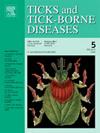Midgut-specific vitellogenin-1 is involved in the negative regulation of Babesia ovata migration or proliferation in Haemaphysalis longicornis tissues
IF 3.4
2区 医学
Q2 INFECTIOUS DISEASES
引用次数: 0
Abstract
Transovarial transmission of bovine Babesia has been experimentally demonstrated using larvae from Haemaphysalis longicornis ticks that are parasitized on cattle infected with Babesia ovata. However, the molecular mechanisms underlying this transovarial transmission remain unclear. We previously showed that vitellogenin (Vg) and its receptor, essential for oogenesis, are key factors involved in Babesia infection in the ovary of H. longicornis. So far, three Vg genes (HlVg-1, HlVg-2, and HlVg-3) have been identified from H. longicornis, but the roles of Vgs other than HlVg-2 in Babesia-infected ticks are unknown. Here, we report the estimated roles of midgut-specific HlVg-1 in Babesia-infected ticks. Following semi-artificial feeding of B. ovata-infected bovine red blood cells, the expression level of HlVg-1 was significantly upregulated at 1 and 2 days after engorgement (dAE). Subsequently, gene silencing mediated via RNA interference (RNAi) was performed to infer the role of HlVg-1 in B. ovata-infected ticks. Interestingly, relative detection levels of Babesia DNA in HlVg-1 RNAi ticks were higher compared with control ticks at 1 and 2 dAE. These results indicate that HlVg-1 might regulate tissue-to-tissue migration or proliferation of Babesia in the tick body. Our data hypothesize that each organ-specific Vg has individual roles during Babesia infection.
中肠特异性卵黄蛋白原-1参与了长角血蜱组织中卵形巴贝斯虫迁移或增殖的负调控
牛巴贝斯虫经卵巢传播已被实验证明,使用长角血蜱的幼虫寄生在感染了卵形巴贝斯虫的牛身上。然而,这种经卵巢传播的分子机制尚不清楚。我们之前的研究表明卵黄原蛋白(vitellogenin, Vg)及其受体是长角天蚕卵巢感染巴贝斯虫的关键因素,是卵发生所必需的。迄今为止,已从长角蜱中鉴定出3个Vg基因(HlVg-1、HlVg-2和HlVg-3),但除HlVg-2外,其他Vg在巴贝斯虫感染蜱中的作用尚不清楚。在这里,我们报告了巴贝虫感染蜱中肠道特异性HlVg-1的估计作用。半人工喂养受卵形芽胞杆菌感染的牛红细胞后,在充血后第1天和第2天,hvrg -1的表达水平显著上调。随后,通过RNA干扰(RNAi)介导的基因沉默来推断HlVg-1在B. ovata感染蜱中的作用。有趣的是,在1和2 dAE时,与对照蜱相比,HlVg-1 RNAi蜱中巴贝斯虫DNA的相对检测水平更高。这些结果表明,HlVg-1可能调节巴贝斯虫在蜱体内的组织间迁移或增殖。我们的数据假设每个器官特异性Vg在巴贝斯虫感染期间具有单独的作用。
本文章由计算机程序翻译,如有差异,请以英文原文为准。
求助全文
约1分钟内获得全文
求助全文
来源期刊

Ticks and Tick-borne Diseases
INFECTIOUS DISEASES-MICROBIOLOGY
CiteScore
6.90
自引率
12.50%
发文量
185
审稿时长
6-12 weeks
期刊介绍:
Ticks and Tick-borne Diseases is an international, peer-reviewed scientific journal. It publishes original research papers, short communications, state-of-the-art mini-reviews, letters to the editor, clinical-case studies, announcements of pertinent international meetings, and editorials.
The journal covers a broad spectrum and brings together various disciplines, for example, zoology, microbiology, molecular biology, genetics, mathematical modelling, veterinary and human medicine. Multidisciplinary approaches and the use of conventional and novel methods/methodologies (in the field and in the laboratory) are crucial for deeper understanding of the natural processes and human behaviour/activities that result in human or animal diseases and in economic effects of ticks and tick-borne pathogens. Such understanding is essential for management of tick populations and tick-borne diseases in an effective and environmentally acceptable manner.
 求助内容:
求助内容: 应助结果提醒方式:
应助结果提醒方式:


